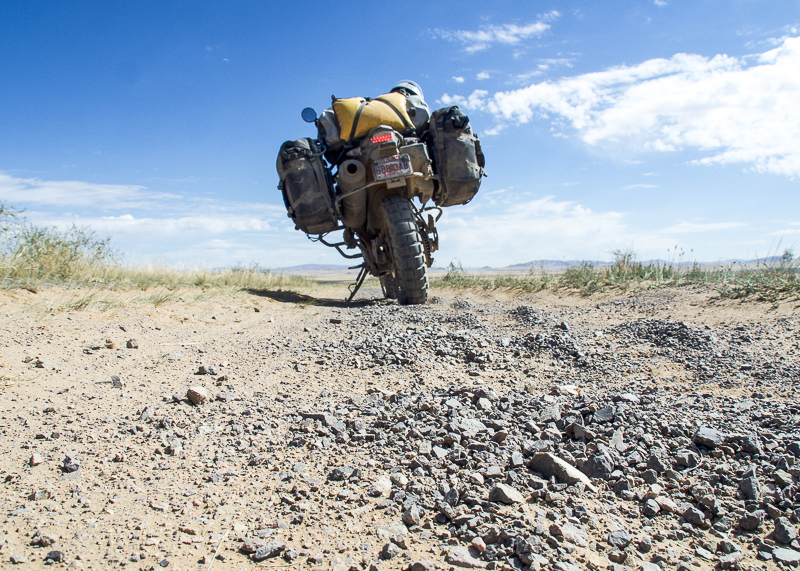Updated April 28, 2021.
Many overlanders have a conundrum—how to carry extra fuel for those far-from-it-all excursions we all dream about. Carrying gas or diesel safely is even more of an issue: gone are the good old days of filling up plastic Coke bottles and strapping them to your overland rig or ADV ride. Even jerry cans with easy-twist caps are no longer. Protection features are now in place due to the Portable Fuel Container Safety Act, making that childproof canister much harder to open and many containers illegal for on-road transportation.
For my round-the-world trip, I tried many fuel storage options from bags, to fuel bottles, to adding an auxiliary tank. In the photo below, I have a Camel ADV tank installed on the rear, right side of my BMW F 800 GS in addition to carrying another 2 gallons or so in the yellow bag you can also see. In many cases, I still ran out of fuel. Sometimes you just can’t carry enough, especially on a motorcycle.
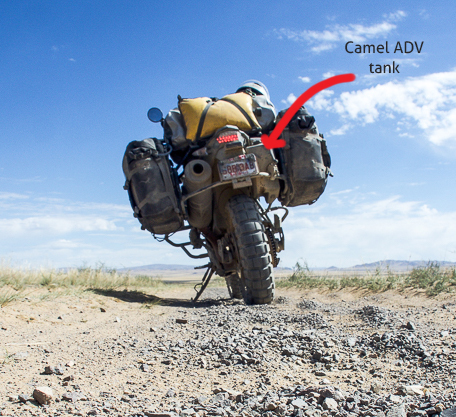
The need to carry extra fuel for longer travel, however, is only increasing as we seek to get farther and farther away, and the only solution is to bring more. The list below offers some options but is by no means exhaustive.
Be sure to check rules and regulations in your area before transporting flammable liquids. Each item listed has its own disclaimer as to how to use them safely. You’ll sometimes see a note that says, “Federal law prohibits the use of this container for the storage of fuel,” even though carrying fuel is exactly what it was designed for. This is so the manufacturer doesn’t have to pay fees that come along with government regulations for fuel containers. Look for D.O.T.-approved cans and read this to see what else is required for travel on public roads and highways.
Note: Weight measurements are dry. For wet weight, add 6.3 pounds per gallon. For example, 5 gallons of fuel will weigh just over 30 pounds. For luggage/roof racks and swing-outs on vehicles, it’s important to know if you can add this extra weight.
1) Giant Loop Gas Bag (moto/vehicle)—$149-300
Capacity: 1-, 2-, 3-, and 5-gallon options
Weight: 11.5 ounces, 15.6 ounces, 21 ounces, 28 ounces
Dimensions: 19.5”x9.5”, 22”x11.24”, 22”x14”, 30”x15”

The SEMA Global Media Award-winning Gas bag’s collapsible frame is made from welded film and ballistic nylon/vinyl-coated polyester.
Pros
Extremely durable, you can drive over it
Collapsible and easily stored in a pannier, backpack, or plastic tub
Filler neck comes standard to allow for most “Blitz” compatible spouts
Cons
Spendy, plus you have to buy a spout/nozzle
Complaints about bag smelling and splitting at below-freezing temperatures
Daisy chain doesn’t run to end of bag to allow for easier strapping
Trailside fueling can get messy without additional spout
2) Twisted Throttle’s Desert Fox Gas Bags (moto/vehicle)—$135-190
Capacity: .79 gallons, 1.6 gallons, 5.3 gallons
Weight: 10.5 ounces, 17 ounces, 30 ounces
Dimensions: 15 x 9.5 inches, 15 x 13 inches, 11.81 x 11.81 x 11.81 inches
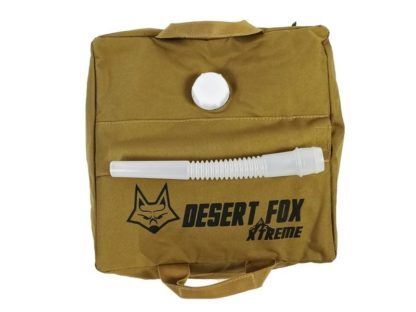
Desert Fox designed their fuel bags for the military so they are able to handle some pretty tough conditions. It’s not clear on the Twisted Throttle website what materials the bags and bladders are made from.
Pros
Much less expensive than Giant Loop’s Gas Bag and you even get slightly more than 5 gallons
Daisy chains all around
Comes with fuel spout inside dust-proof pouch
Comes with tie-down straps
Cons
Sleeve for spout isn’t long enough to close Velcro
Website is clunky and inconsistent
Twisted Throttle’s customer service could use some improvements
3) RotopaX (moto/vehicle)—$80
Capacity: 2 gallons (multiple combo options available)
Weight: not specified and need to take mount into consideration
Dimensions: 17.75 x 13.25 x 3 inches
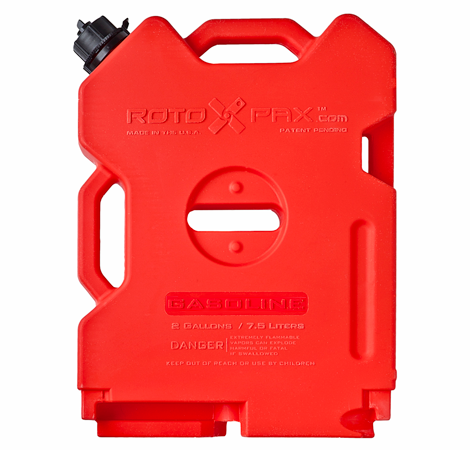
I’ve used a RotopaX on my BMW F 800 GS and can attest to its durability, slick design, and functionality. I never had a problem with mine leaking or pressurizing, though it is recommended you vent them once per day with elevation or temperature changes.
Pros
Only rotationally molded EPA and CARB-compliant containers available in US
Lockable so you can leave them unattended
Stay put while bouncing along rough terrain
Color-coded for water, fuel, and first aid
Leakproof and stackable
Easy to fill and pour
Cons
Top-heavy for motorcycles when full and on rack behind rider; uneven if on side rack
Requires their pack mounts (AltRider sells them pre-drilled for bikes. Vehicle options are here.)
Locking Mount is an additional cost
Always there, not collapsible
Requires manual venting
4) Fuel bottles (moto/vehicle)—$30
Capacity: 31 ounces
Weight: 7.5 ounces
Dimensions: 9.8 x 3.1 inches
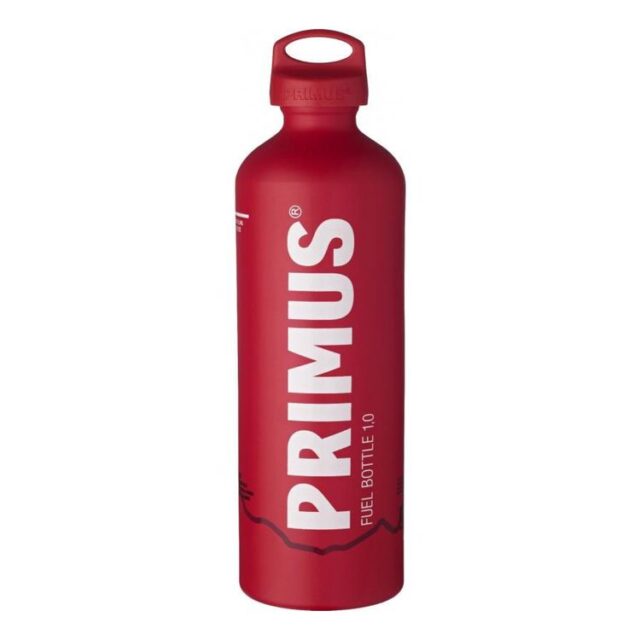
This one from Primus, for example, can be a cheap option. However, my husband came out of a hotel room one hot morning to find the fuel bottle strapped to his bike had split due to expansion pressure. Keep this in mind when parking in direct sun.
Pros
Cheap option if you only need a little extra fuel as a safety net
Can double as use for camping stoves with the right adaptor
Cons
Limited carrying capacity. You would need about 20 to equal 5 gallons, which starts to add up in cost and space. Add a handy dandy bottle holder and you now have a $60 fuel bottle.
Potential for aluminum to crack in heat and elevation changes
Opening is too narrow for a pump
Childproof cap is annoying
Some complaints of cap leaking
5) Tuff Jug Utility Jug (moto/vehicle)—$24 and up
Capacity: 2.7 or 5 gallons
Weight: not specified
Dimensions: not specified

A low-profile jug for any type of fuel.
Pros
Durable
Carrying handle makes for easy strap-down
Large opening for fill-ups
Plug cap can be swapped out for filler spout (sold separately)
Small size and side handle easier to lift/use than traditional jugs
Stack well next to each other in a vehicle or trailer
Cons
Complaints of leakage
Not as durable as other options
6) Touratech Fuel Canister (moto/vehicle)—$28 (by itself)
Capacity: .79 gallons
Weight: not specified
Dimensions: 8.25 x 4 x 8 inches

Mounts securely to your bike or vehicle with the Zega Fuel Holder and Touratech Arno straps.
Pros
Opening is large enough for service station nozzles
Comes with filler spout
Inexpensive
Cons
Spout does not store inside canister and it’s recommended spout only be used with vehicles
Black color could heat up really quick
Not easily stored unless investing in mount and straps
Not as durable as other options
7) Rugged Ridge Jerry Can (vehicle only)—$55
Capacity: 5.28 gallons
Weight: not specified but may be similar to the Wavian can below
Dimensions: not specified but may be similar to the Wavian can below
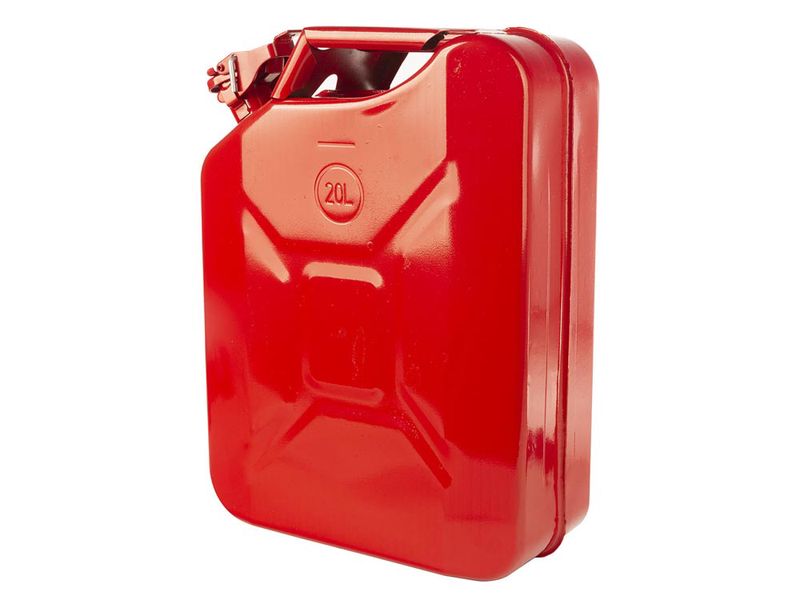
Stamped steel construction for vintage styling with gloss finish and sturdy 3-bar handle.
Pros
Limited 5-year warranty and 30-day return
Cool vintage look in red or green
Safe and reliable
Less expensive than the Wavian can below
Cons
Not compact
Can dent easily
Complaints of can not sealing properly due to rubber gaskets swelling
Mount not specified, but would store better
8) Wavian Gas Can (vehicle only)—$80
Capacity: 1.3 gallons, 2.6 gallons, 5.3 gallons
Weight: 4.7 pounds, 7.5 pounds, 12 pounds
Dimensions: 9 x 5 x 14 inches, 6 x 13 x 125 inches, 6 x 13 x 181 inches
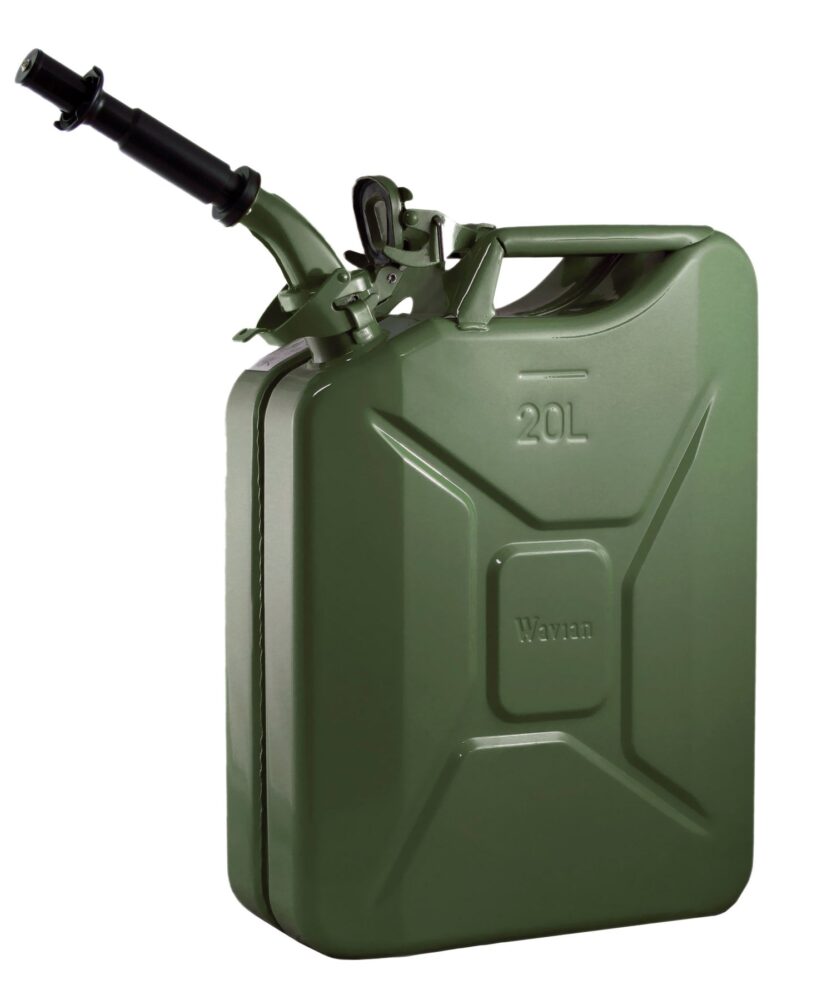
This original NATO steel jerry can is similar to the Rugged Ridge above in style, but with more color choices. The selling feature on this can might be its High-flow Safety Spout with automatic shut-off.
Pros
Safety spout ventilated and ideal for fast, non-spill pours. Withdrawing spout automatically stops pour.
Flexible nozzles are also available
Locking pin in cap
Leak-proof bayonet closure
Three-handle configuration for easy pouring, grabbing, and carrying
Claim highest quality jerry cans on market today
Rust-proof lining
Rigorously tested
Cons
Not compact or collapsible
Can dent easily
Mount not specified, but would store better
Expensive
9) Camel Auxiliary Tank (moto only)—$389.00 (Price fluctuates depending on bike)
Capacity: 1.8 gallons
Weight: 5.3 pounds
Dimensions: 17.5” x 5.5 x 8.5 inches

This costly but ideal solution installed on my BMW F 800 GS increased my range to over 300 miles. Note, there are a few other ways to add auxiliary tanks to ADV bikes.
Pros
Tucks in neatly behind luggage racks for added protection and streamlined look
Fits lower on bike than RotopaX or collapsible bags for better center of gravity
Easy to fill when you fill your tank, and wide opening for nozzle
Internal lines feed into main tank, so no messy trailside top-ups needed
Camel Tank empties before your bike’s tank; fuel gauge stays accurate
Legal to run on-road
Excellent, in-depth install video
Cons
Additional weight always affixed to bike
Not as much range as other options
You’ll need to drill two holes in the fairing for fuel lines
A more complicated install than strapping fuel bags to your bike
10) JohnDow Diesel Carrytanks (vehicle only)—$839.99
Capacity: 58 and 106 gallons
Weight: 56 pounds; 118 pounds
Dimensions: not specified
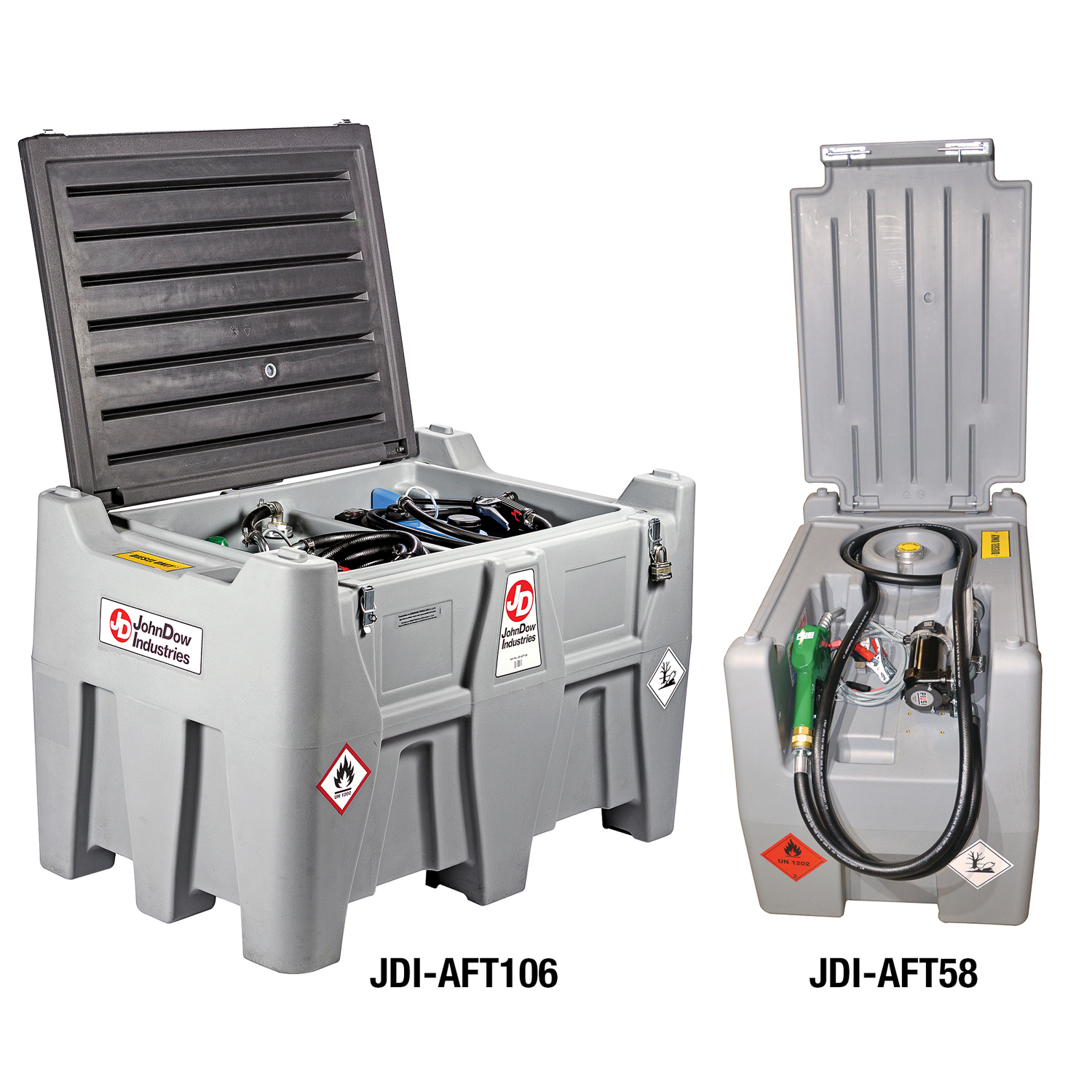 If you want to go full-on self-contained and basically carry along your own fueling station, the JohnDow is for you. Note this tank is for diesel only.
If you want to go full-on self-contained and basically carry along your own fueling station, the JohnDow is for you. Note this tank is for diesel only.
Pros
Huge range
Can remove and leave in a base camp
Comes with 12-volt pump, hose, and automatic nozzle
Delivers fuel at 10 gallons per minute
Forklift pockets but easy to carry when empty
Lockable
Cons
Takes up a lot of space in your overlanding rig
Diesel only
Needs 12-volt power source
Comments that cover latches don’t line up (UPDATE Apr. 29, 2021—this issue has been resolved on the JDI-AFT58.)
Battery terminal wires are too short unless unit is placed at very front of bed of truck
There are as many overlanding vehicle configurations as there are overland travelers. Take the time to think about what’s right for you: how much fuel do you actually need; how often will you go far enough to need it; do you want storage capacity for emergencies only or for getting as far away as possible? Hopefully, some of the options above help you choose the best one for you.
Our No Compromise Clause: We carefully screen all contributors to make sure they are independent and impartial. We never have and never will accept advertorial, and we do not allow advertising to influence our product or destination reviews.


